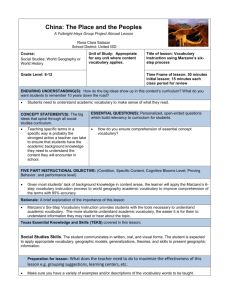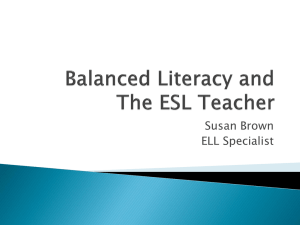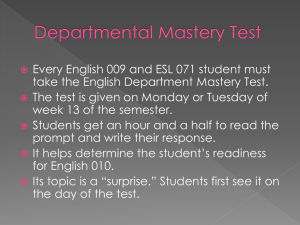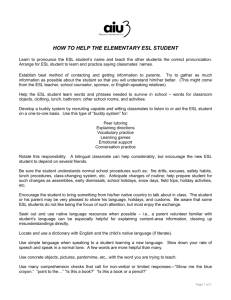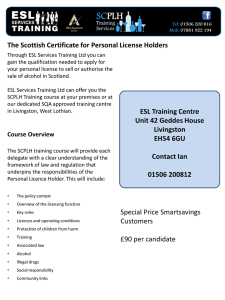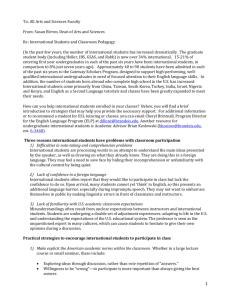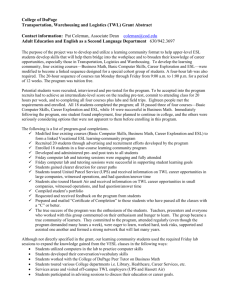Marzano`s 6 Steps
advertisement
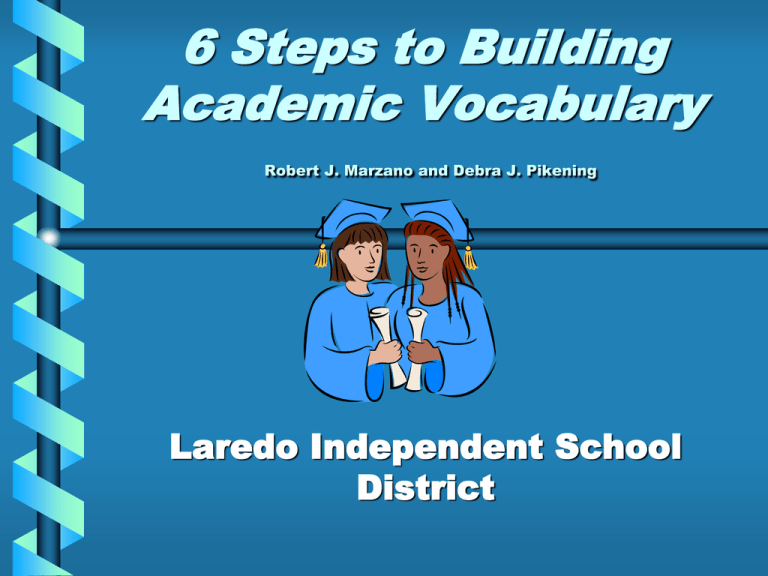
6 Steps to Building Academic Vocabulary Robert J. Marzano and Debra J. Pikening Laredo Independent School District Four Levels of Word Recognition FULL Word Knowledge – students understand the meaning and how the word changes in context PARTIAL Word Knowledge – students know the word in context and can use it in their writing INITIAL Word Knowledge – students recognize the word and can pronounce it, but do not know its meaning UNKNOWN Word – student cannot read or recognize the word Why teach vocabulary? “Teaching specific terms in a specific way is probably the strongest action a teacher can take to ensure that students have the academic background knowledge they need to understand the content they will encounter in school.” Why teach vocabulary? “While sight word instruction provides a background of words seen most frequently, vocabulary instruction is needed for those terms that are not necessarily frequent in typical reading, but inherent to certain genres, purposes and topics.” Why teach vocabulary? “As students engage in more and more content-area reading, their knowledge of specific vocabulary terms becomes more important. Explicit vocabulary instruction is necessary to improve comprehension and fluency when engaging with nonfiction text or content related materials.” Six-Step Process for Teaching New Terms Explain Initial Information: Introduce New Term Provide a student friendly description, explanation, or example of the new term. Find out what they know or think they know (prior knowledge) about the term. Clarify misconceptions, build on accurate information. Help build an understanding of the term. Notes: Looking up words in dictionaries is not useful for teaching vocabulary Provide a context for the term Introduce direct experiences that provide examples of the term Tell a story that integrates the term Use video as the stimulus for understanding information Ask students to investigate the term and present the information to the class (skit, pantomime, poster, etc…) Describe your own mental picture of the term Find or create pictures that explain the term Working with ESL Students: Step 1 If possible, explain, or have someone else explain the term in the student’s native language. Pair students or triads of students with the same language together. Solicit help from a para-professional. Provide some sort of non-linguistic representation. Restate Students Restate Term “Informal Information” Ask students to restate description, explanation or example in their own words. Provide a more natural starting pointconnect prior experiences and knowledge. Notes: Must be student’s original ideas, not parroting the teacher Monitor and correct misunderstandings Provide more explanations or examples as necessary Have students record these ideas in an academic notebook Working with ESL Students: Step 2 Permit students to write their own definition in their native language. Encourage students to record any related English terms with which they are familiar. Show Non-linguistic Representation Ask students to construct a picture, symbol or graphic representing the term. Notes: Model, model, model Provide examples of students’ drawings (and your own) that are rough but represent the ideas Play “Pictionary” Draw examples of the term Dramatize the term using speech bubbles Let them find a picture on the internet, if necessary Have students record these ideas in an academic notebook What if… Students have trouble depicting the term? Draw actual object Blue Prints Draw an example Single Parent Family Represent with Graphics Problem Solving Process Dramatize with cartoons an speech balloons Problem Solving Process I have a new and different idea! Working with ESL Students: Step 3 Non-linquistic representation is EXTREMELY important when working with ESL students. Discuss Student/Term Interaction Engage students periodically in activities that help them add to their knowledge of the terms. Allow them to work in their vocabulary notebooks. Notes: Highlight prefixes, suffixes, root words that will help them remember the meaning of the term Identify synonyms and antonyms of the term List related words Write brief cautions or reminders of common confusions Translate the term into another language for second language learners Point out cognates to word in Spanish Write incomplete analogies for students to complete Allow students to write or draw their own analogies Sort or classify words Compare similarities and differences Have students record these ideas in an academic notebook Working with ESL Students: Step 4 As much as possible, allow students to work in their native language. Refine and Reflect Discuss Terms with Others Periodically ask students to discuss terms with one another. Notes: Think-Pair-Share Compare their descriptions of the term Describe their picture to one another Explain to each other any new information they have learned (“aha’s”) Identify areas of disagreement or confusion and seek clarification Students can make revisions to their work (notebook) Working with ESL Students: Step 5 Use triads or pairs of students with the same native language. Use para-professionals or parents to assist. Review and Apply in Learning Games Review and Games Involve students periodically in games that allow them to play with the terms. The goal is to keep new terms in the forefront of the students’ thinking and allow them to reexamine their understanding of the terms. Notes: (As students play, walk around the room monitor and listen for misconceptions – clarify as needed and check notebooks to evaluate accuracy.) Pictionary Memory Jeopardy Charades Name that Category ($100,000 Pyramid) Password Bingo Create Skits etc… http://jc-schools.net/tutorials/vocab/strategies.html Working with ESL Students: Step 6 Use triads or pairs of students with the same native language. Use para-professionals or parents to assist. PLAN TO IMPLEMENT: Schedule Time direct instruction (steps 1-3) Students interaction time (steps 4-6) Monitor accuracy of student work Keep track of student progress

